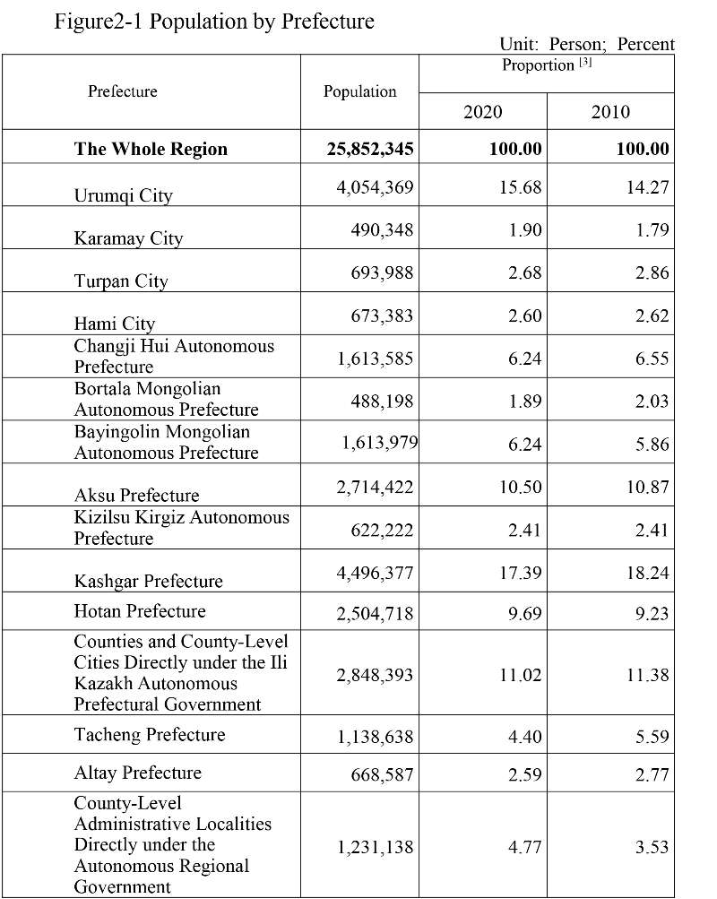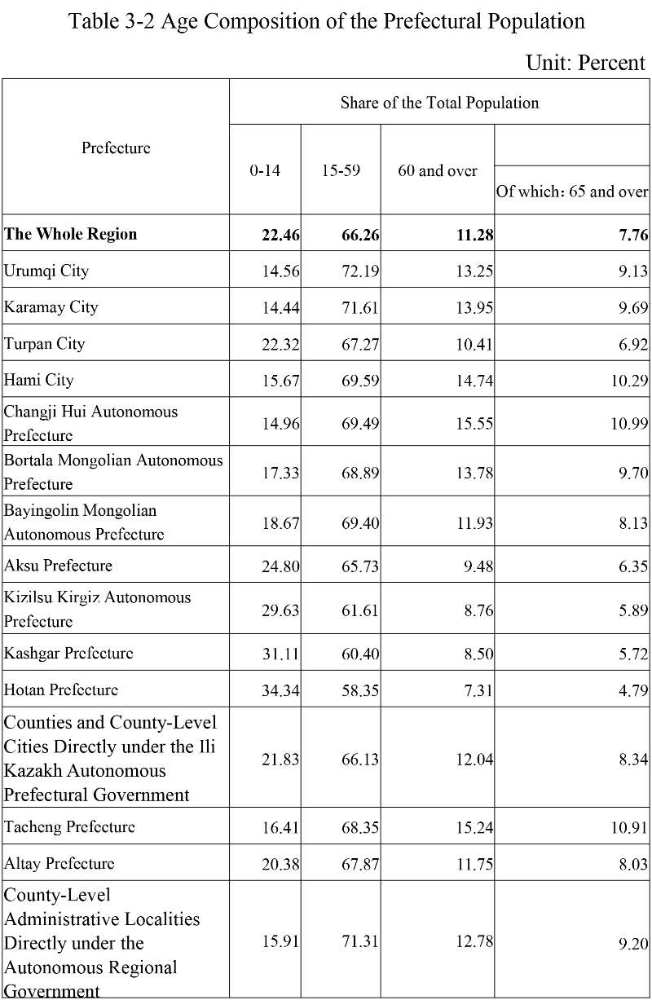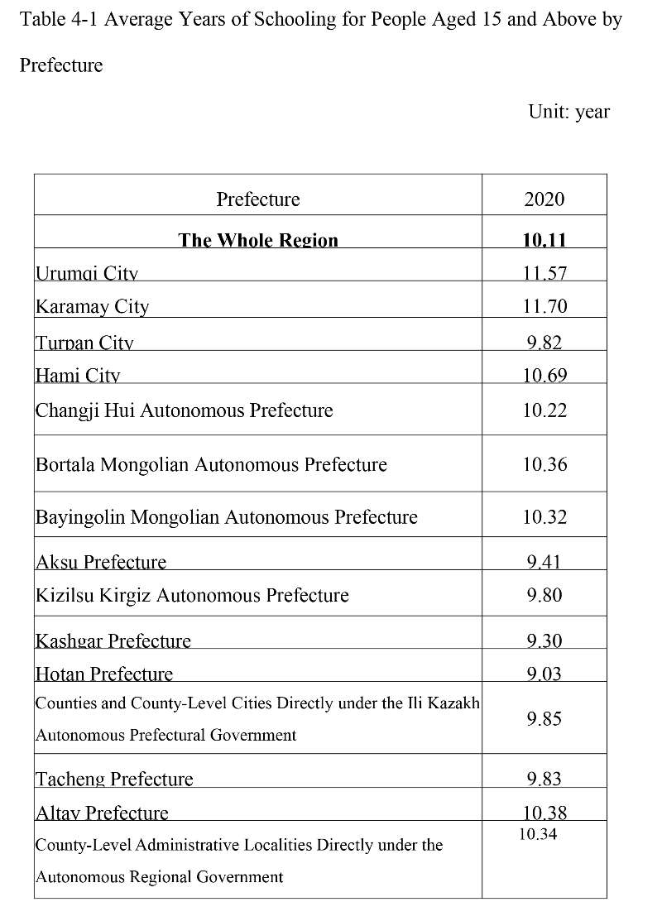| Communiqué of the Census Data of Xinjiang Uygur Autonomous Region from the Seventh National Population Census(No. 1,2,3,4,5) |
| 2021-06-14 19:06 |
Communiqué of the Census Data of Xinjiang Uygur Autonomous Region from the Seventh National Population Census (No. 1) -Basic Information of the Regional Population[1] Statistical Bureau of Xinjiang Uygur Autonomous Region Office of the Leading Group of Xinjiang Uygur Autonomous Region for the Seventh National Population Census 14 June, 2021 Based on the results of the Seventh National Population Census, released as follows are the basic information of the permanent resident population[2] of Xinjiang Uygur Autonomous Region at 00:00 hours of November1, 2020. I. Total Population The population of permanent residents of Xinjiang Uygur Autonomous Region was 25,852,345 persons. II. Population Growth Compared with the permanent resident population of 21,813,334 persons recorded from the Sixth National Population Census in 2010, the regional permanent population increased by 4,039,011 persons, or 18.52 percent, and the average annual growth rate was 1.71 percent, which were 13.14 percentage points and 1.18percentage points respectively higher than the national average. III. Population of Ethnic Groups Among the population of permanent residents in the region, 10,920,098 persons or 42.24 percent were of Han ethnicity, 11,624,257 persons or 44.96 percent were of Uygur ethnicity, and 3,307,990 persons or 12.80 percent were of other ethnic minorities Compared with the Sixth National Population Census, there was an increase of 2.174 million persons of Han ethnicity from the Seventh National Population Census, in which the Han population who had moved from other provinces increased by 1.948 million persons; the Uygur population increased by 1.623 million persons or 16.2 percent. Notes: [1]All figures in this Communiqué are preliminary results. Due to the rounding-off reasons, the subentries may not add up to the aggregate totals. [2]Permanent Residents include people living in the current town/street where their household registration is located or with their household registration to be settled; people living in the current town/street and leaving the town/street of their household registration for 6 months; people leaving the town/street of their household registration for less than 6 months or working or studying overseas, with their household registration located in the current town/street. Communiqué of the Census Data of Xinjiang Uygur Autonomous Region from the Seventh National Population Census (No. 2) -Population by Prefecture[1] Statistical Bureau of Xinjiang Uygur Autonomous Region Office of the Leading Group of Xinjiang Uygur Autonomous Region for the Seventh National Population Census 14 June, 2021 Based on the results of the Seventh National Population Census, released as follows are the data of the permanent residents[2] in the 14 prefectures, cities and county level cities directly under the autonomous regional government of Xinjiang at 00:00 hours of November1, 2020. In these 14 cities and prefectures, there are 5 cities and prefectures with the population of more than 2 million, 3 cities and prefectures with the population of 1 million to 2 million, 4 cities and prefectures with the population of 0.5 million to 1 million, 2 cities and prefectures with the population less than 0.5 million. The most five populous cities and prefectures in total accounted for 64.28 percent of the regional population. Notes: [1]All figures in this Communiqué are preliminary results. Due to the rounding-off reasons, the subentries may not add up to the aggregate totals. [2]Permanent Residents include people living in the current town/street where their household registration is located or with their household registration to be settled; people living in the current town/street and leaving the town/street of their household registration for 6 months; people leaving the town/street of their household registration for less than 6 months or working or studying overseas, with their household registration located in the current town/street. [3]It refers to the proportion of permanent residents of the prefectures, cities and county-level counties directly under the autonomous regional government to the regional population. Communiqué of the Census Data of Xinjiang Uygur Autonomous Region from the Seventh National Population Census(No. 3) -Age Composition[1] Statistical Bureau of Xinjiang Uygur Autonomous Region Office of the Leading Group of Xinjiang Uygur Autonomous Regionfor the Seventh National Population Census 14 June, 2021 Based on the results of the Seventh National Population Census, released as follows are the data of age composition of the population of 14 prefectures, cities and county level cities directly under the autonomous regional government of Xinjiang (hereafter referred to as prefectures and cities) at 00:00 hours of November1, 2020. I. Age Composition of Regional Population Of the regional population[2], 5,806,156 persons were in the age group of 0-14[3], accounting for 22.46 percent; 17,129,180 persons in the age group of 15-59, accounting for 66.26 percent and 2,917,009 persons in the age group of 60 and over, accounting for 11.28 percent; of which, 2,005,885 persons were in the age group of 65 and over, accounting for 7.76 percent. II. Age Composition of Regional Population Of the 14 prefectures and cities, 2 prefectures and cities had the share of people in the age group of 0-14 over 30 percent, 5 prefectures and cities between 20 percent to 30 percent and 7 prefectures and cities below 20 percent; 11 prefectures and cities had the share of people in the age group of 15-59 over 65 percent, 2 prefectures and cities between 60 percent to 65 percent and one prefecture or city below 60 percent. The share of people aged 65 and over was above 7 percent in 9 prefectures and cities, whereas in 5 prefectures and cities the same indicator is below 7 percent. Notes: [1]All figures in the Communiqué are preliminary results. Due to the rounding-off reasons, the subentries may not add up to the aggregate totals. [2]The regional population refers to the population of permanent residents in the 14 prefectures, cities and county level cities directly under the regional government of Xinjiang, excluding residents of Hong Kong, Macao and Taiwan and foreigners living in the 14 prefectures, cities and county level cities directly under the autonomous regional Government. [3]There were 6,118,388 persons in the age group of 0-15 and 16,816,948 persons in the age group of 16-59. Communiqué of the Census Data of Xinjiang Uygur Autonomous Region from the Seventh National Population Census (No. 4) -Educational Attainment[1] Statistical Bureau of Xinjiang Uygur Autonomous Region Office of the Leading Group of Xinjiang Uygur Autonomous Regionfor the Seventh National Population Census 14 June, 2021 Based on the results of the Seventh National Population Census, released as follows are the data of education attainment of the population of 14 prefectures, cities and county level cities directly under the autonomous regional government of Xinjiang (hereafter referred to as prefectures and cities) at 00:00 hours of November1, 2020. I. Composition of Educational Attainment Of the regional population[2], there were 4,274,826 persons with university education (referring to junior college and above); 3,414,458 persons with senior secondary school education (including secondary technical school); 8,158,620 persons with junior secondary school education; and 7,343,482 persons with primary school education (the persons with various educational attainment levels include graduates, dropouts and students at school). Compared with the Sixth National Population Census in 2010, the persons with university education per 100,000 persons went up from 10,635 to 16,536; the persons with senior secondary school education up from 11,582 to 13,208; the persons with junior secondary school education down from 36,096 to 31,559; the persons with primary school education down from 30,075 to 2,8405. II. Average Years of Schooling[3] Compared with the Sixth National Population Census in 2010, of the regional population, the average years of schooling for people aged 15 and above increased from 9.27 years to 10.11 years. Among the 14 prefectures and cities, the average years of schooling were above 10 years in 7 prefectures, and less than 10 years in 7 prefectures. Notes: [1]All figures in the Communique are preliminary results. Due to the rounding-off reasons, the subentries may not add up to the aggregate totals. [2]The regional population refers to the population of permanent residents in the 14 prefectures, cities and county level cities directly under the regional government of Xinjiang, excluding residents of Hong Kong, Macao and Taiwan and foreigners living in the 14 prefectures, cities and county level cities directly under the autonomous regional government. [3]Average years of schooling are means of schooling years converted from the duration of each level of education. Specifically, primary school=6years, junior secondary school=9years, senior secondary school=12 years, and junior college and above=16 years. Communiqué of the Census Data of Xinjiang Uygur Autonomous Region from the Seventh National Population Census (No. 5) -Urban and Rural Population and Floating Population[1] Statistical Bureau of Xinjiang Uygur Autonomous Region Office of the Leading Group of Xinjiang Uygur Autonomous Region for the Seventh National Population Census 14 June, 2021 Based on the results of the Seventh National Population Census, released as follows are the data of the urban and rural distribution and migration of population in the 14 prefectures, cities and county level cities directly under the autonomous regional government of Xinjiang at 00:00 hours of November1, 2020. I. Urban and Rural[2] Population Among the regional population[3], there were 14,613,622 persons living in urban areas, accounting for 56.53 percent; 11,238,723 persons living in rural areas, accounting for 43.47 percent. Compared with the Sixth National Population Census in 2010, the urban population increased by 5,277,870 persons and the rural population decreased by 1,241,340 persons. The urban population share went up by 13.73 percent. II. Floating Population Of the floating population in the region that totaled 8,051,404, the population moving from other provinces reached 3,390,712, and the population moving within the provinces numbered 4,660,692. Compared with the Sixth National Population Census in 2010, the floating population was up by 4,061,118 persons, with an increase of 101.78 percent. Notes: [1]All figures in the Communiqué are preliminary results. Due to the rounding-off reasons, the subentries may not add up to the aggregate totals. [2]Urban and rural areas are classified based on the Regulation on Classification of Urban and Rural Areas for Statistics issued by the National Bureau of Statistics of China. [3]The regional population refers to the population of permanent residents in the 14 prefectures, cities and county level cities directly under the regional government of Xinjiang, excluding residents of Hong Kong, Macao and Taiwan and foreigners living in the 14 prefectures, cities and county level cities directly under the autonomous regional government. Source:Tianshannet |




